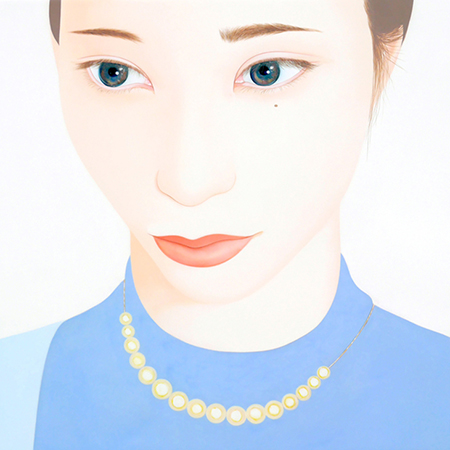
Yasuyo Maruyama’s compelling exhibition of 11 paintings display high contrasts in color, with a graphic flatness and hardedge visual transitions. These severely cropped faces in extreme close-up combine complex composition, naturalist painting techniques, and age-old subject matter to evoke powerful emotions. The stunning signature piece, “Sakiko 2,” is a perfect embodiment of what the artist has achieved. A female face cropped from above, alternately bordered by green and blue with dramatic transitions from one color to the other, stares into the distance.
All of the portraits are pared down so only essential features remain, imbedded in solid, polished, colors that make up backgrounds or hair and facial features. Executed on small panels, Maruyama’s interest in Japanese calligraphy is visible via her repeated use of an array of brushes and tools to depict hair, eyelashes and eyebrows with single precise lines.
The portraits are of friends and acquaintances of Maruyama. The flatness of the panel support augments the stunning hyperreality of the images. They owe a debt to Japanese ukiyo-e wood block prints, which translates as “pictures of the floating world.” The subjects, indeed, seem to float within the frame, alternatively making direct eye contact with us or denying it altogether. We can’t escape being absorbed in the gaze of “Emma G 2,” while “Kahoko 3,” lost in thought, looks past us, avoiding eye contact altogether. Most compositions are portrait busts of head and neck. Three of the works here, “Takumi,” “Takumi 2” and “Alex 2,” include a single hand on which the subjects’ head rests lightly and comfortably.
But it’s through the eyes that Maruyama unifies this body of work, lifting them into an ethereal realm. The eyes are formed through laying down multiple layers of opaque and transparent oil paint. The resulting anatomy bears no resemblance to actual human eyes, unlike and in contrast with the directness and simplicity of the rest of the facial features. This is the most striking element in the paintings; the people become otherworldly, evoking but distinctive from references to cyborgs, Japanese anime films and manga comics. This body of work suggests that the overwhelming pop art style in the world of Takashi Murakami, or the postmodernism of Mamoru Oshii’s animated masterpieces such as “Ghost in the Shell,” have been supplanted by the austere serenity and graceful treatment we find in Maruyama.
